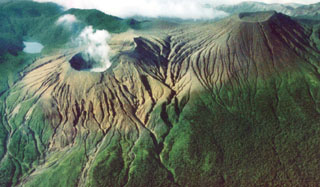Report on Rincon de la Vieja (Costa Rica) — September 1993
Bulletin of the Global Volcanism Network, vol. 18, no. 9 (September 1993)
Managing Editor: Edward Venzke.
Rincon de la Vieja (Costa Rica) Crater lake level drops 10 m
Please cite this report as:
Global Volcanism Program, 1993. Report on Rincon de la Vieja (Costa Rica) (Venzke, E., ed.). Bulletin of the Global Volcanism Network, 18:9. Smithsonian Institution. https://doi.org/10.5479/si.GVP.BGVN199309-345020
Rincon de la Vieja
Costa Rica
10.8314°N, 85.3364°W; summit elev. 1729 m
All times are local (unless otherwise noted)
A visit to the active crater on 6 October took place in bad weather, but scientists found strong fumarolic activity and a >10 m drop in lake level compared to September 1992. The lake level began changing after the 8 May 1991 phreatic eruption.
Low-frequency microseismic activity increased over the last 3 months, with three events in July, five events in August, and 93 events in September. Tremor was not reported in July, 165 minutes of tremor occurred in August, and no tremor was detected in September. Dry-tilt for the interval from November 1992 to July 1993 indicated an 11 µrad radial deflation; in contrast, the majority of intervals as far back as 1987 showed little or no change.
Geological Summary. Rincón de la Vieja is a volcanic complex in the Guanacaste Range of NW Costa Rica. Sometimes referred to as the Rincon de la Vieja-Santa María Volcanic Complex, it consists of a slightly arcuate 20-km-long ridge of 12 craters and pyroclastic cones constructed within the 15-km-wide early Pleistocene Guachipelín caldera, whose rim is exposed on the south side. Sometimes known as the "Colossus of Guanacaste," it has an estimated volume of 130 km3 and contains at least nine major eruptive centers. The Santa María cone, the highest peak of the complex, is located on the E side of the ridge and has a lake within the 400-m-diameter crater. A Plinian eruption producing the 0.25 km3 Río Blanca tephra about 3,500 years ago was the last major magmatic eruption. All subsequent eruptions, including numerous reported eruptions possibly dating back to the 16th century, have been from the active crater, near the center of the complex, with an acidic 300-m-diameter lake.
Information Contacts: E. Fernández, J. Barquero, R. Van der Laat, F. de Obaldia, T. Marino, V. Barboza, and R. Sáenz, OVSICORI; G. Soto, Guillermo E. Alvarado, and Francisco Arias, ICE; Héctor Flores, Univ. de Costa Rica.

